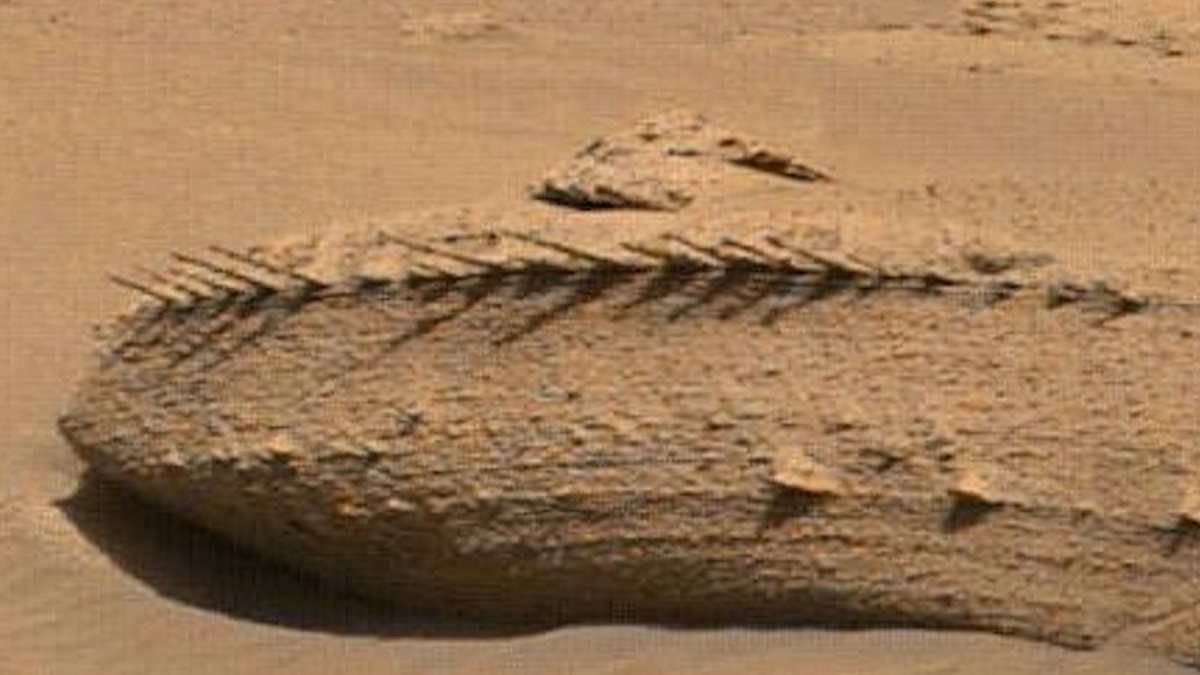
Alleged Mars anomaly could be debris of crashed alien spacecraft, scientists claimed. Pic credit: NASA/JPL-Caltech via Neville Thompson/Gigapan.com
Research scientists claimed that strange features spotted on Mars could be the debris field of a crashed alien spacecraft.
The alleged evidence comes from a photograph of the surface of the Red Planet that NASA’s Curiosity Rover snapped at the Gale Crater region in April.
The photo appears to show anomalous structures on Martian rock. The alleged anomalies include spiky, wedge- and plate-like formations jutting from rocks in the crater.
Researchers speculated that the features could be the debris from an alien spacecraft that crashed on the surface of Mars.
Astrobiologist Nathalie Cabrol: “Most bizarre rock I have ever seen”
Dr. Nathalie Cabrol, an astrobiologist at NASA’s Ames Research Centre and Search for Extraterrestrial Intelligence (SETI) Institute, drew attention to what seemed to be anomalies on the Martian surface in an April 2023 tweet.
While examing the photos of the Martian surface taken by the Curiosity Rover, she noticed strange structures on a rocky patch in the Gale Crater area.
[Note: The Gale Crater is a 3.5 billion-year-old depression on Mars formed by a meteorite impact. The crater, about 54 km (96 miles) in diameter, is in the northwestern part of the Red Planet known as the Aeolis quadrangle.]
“In 20 years of studying Mars, that’s the most bizarre rock I have ever seen,” she tweeted. “I cannot wait to have a microscopic image of this one.”
The features included multiple rocks with spiky, wedge- and plate-like objects sticking from their surfaces (see image above).
Anomalies could be biological fossil
Some social media users suggested they could be the fossil remains of large fish or dinosaur-like biological species that once lived on the planet.
Others speculated they could be due to the activity of microbial organisms or remains of algae or fungi-like organisms.
Anomalies could be remains of NASA spacecraft
However, some believed they could be the debris from NASA spacecraft that crashed on Mars or parts discarded during the landing.
Several NASA spacecraft have crashed on the Red Planet in the past.
NASA also abandoned multiple rovers on Mars after they stopped working. For instance, the Mars Polar Lander crashed on the Martian surface, while the Mars Pathfinder mission’s Sojourner Rover stopped working after landing.
Other NASA rovers that stopped working after years of exploring the planet’s surface include Spirit and Opportunity.
Strange features may be “sand spikes”
Some researchers suggested that the seeming anomalies could be due to natural astrogeological processes.
According to The Telegraph, a team of researchers led by Professor Richard Amstrong from Birmingham’s Aston Univerity argued in a study recently published in the Journal of Astrobiology that the spiky structures resembled “sand spikes” found on Earth.
Strong seismic activity on Earth may cause “sand spikes” in sandy and water-logged terrain.
They occur around Mount Signal, near the San Andreas Fault in southern California. They also occur in the North Alpine foreland basin, near western Bavaria’s Nördlinger Ries impact crater from the Miocene age.
Structures could be crash site debris
However, Armstrong told the Telegraph that he and his team believed the features were likely due to astrogeological processes native to Mars. However, they could not entirely discount the possibility that they were debris from a crashed alien spacecraft.
He said that since they could not prove that the features were seismic “sand spikes,” it was possible to speculate that they were debris from a crashed alien spacecraft.
But the researcher said it was unlikely to be the debris of human technology because they did not look like fragments from known human-made objects that landed on the planet.
Axle and wheels on Mars
Armstrong also mentioned that it was not the first time people claimed they saw anomalies on the planet.
Researchers previously reported seeing objects that resembled an axle and wheels at a nearby site on the Gale Crater.
Pareidolia: Why people sometimes see familiar patterns on Mars
According to Armstrong, researchers may expect to see features on the Martian surface that suggest familiar patterns or objects. But he noted that any debris from human or alien technology would likely have been severely wind-eroded before humans saw them.
The tendency to perceive logical connection when presented with otherwise random stimuli is called apophenia.
Pareidolia is a form of apophenia in which people see familiar objects or patterns in random stimuli.